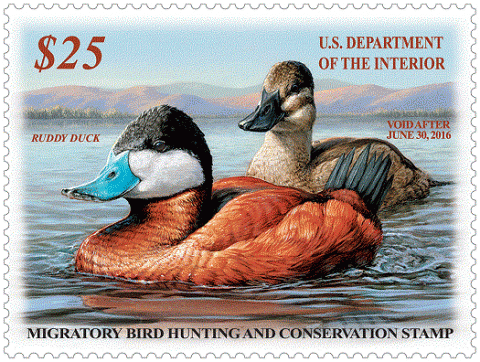Did you know that 98 percent of the proceeds from sales of the federal duck stamp go to the Migratory Bird Conservation Fund? This fund supports wetland acquisition and conservation easements for the National Wildlife Refuge System.
In the early 20th century, waterfowl population numbers were at an all-time low. Factors contributing to this decline included a poor understanding of biology, drainage of wetlands, inadequate farming practices and over-harvesting. Something had to be done to save waterfowl species from extinction.
In 1933, President Franklin Delano Roosevelt appointed a special committee to evaluate the dire situation of declining waterfowl populations and to recommend a waterfowl management restoration plan. Committee members included J.N. “Ding” Darling, Dr. Thomas H. Beck, and Aldo Leopold, who were all known conservationists. To counteract the decline and maintain healthy waterfowl populations, the committee recommended several laws and regulations be enacted including bag limits; hunting licenses; hunting times; prevention of interstate transport and sale of wildlife, arms and ammunition restrictions; and the passage of the Migratory Bird Treaty Act.
The committee also recommended the federal government spend $25 million on wildlife restoration to purchase 12 million acres of land for wildlife protection. The committee had support for this proposal, but the federal government had no way of funding it. Two groups brought valid ideas to the table. The American Game Protective Association (now the American Wildlife Conservation Foundation) had been advocating for years the passage of the duck stamp bill using the slogan “ducks for a dollar.” More Game Birds for America (now Ducks Unlimited) supported a one-cent tax on shotgun shells to raise revenue. The duck stamp became the favored idea and President Roosevelt signed the Migratory Bird Hunting Stamp Act into law on March 16, 1934.
J.N. “Ding” Darling, director of the Bureau of Biological Survey (forerunner to today’s U.S. Fish and Wildlife Service), was also an artist and cartoonist. He created the first design for the stamp, commonly referred to as the “Federal Duck Stamp.” The stamp was enacted as a federal license to hunt migratory waterfowl. Under this act, all waterfowl hunters over the age of 15 must purchase and carry a Federal Duck Stamp annually. This program is managed under the United States Department of Interior’s U.S. Fish and Wildlife Service, and approximately 98 cents out of every dollar spent on a federal duck stamp goes into the Migratory Bird Conservation Fund. This money is used to purchase wetlands and wildlife habitat as a part of the National Wildlife Refuge System. The land purchased not only benefits waterfowl, but numerous other species of birds, mammals, fish, reptiles and amphibians. It is also estimated that one-third of the nation’s endangered and threatened species use habitats in the National Wildlife Refuges. A current Federal Duck Stamp is also good for free admission to any refuge that charges an entry fee.
Since 1934, more than 135 million Federal Duck Stamps have been purchased. These purchases have generated almost $1 billion for the Migratory Bird Conservation Fund, and have been used to purchase close to 6 million acres of habitat.
In Alabama alone, almost 1 million Federal Duck Stamps have been purchased since the act’s inception. With the protected habitat and rebound in wildlife population numbers, the Federal Duck Stamp Program has been called one of the most successful conservation programs ever. In fact, many states and other countries have emulated the program by creating hunting stamps of their own to generate revenue for wildlife conservation and habitat protection. Alabama has had a state duck stamp since 1979.
If you are not a duck hunter, you can still purchase a duck stamp. Birders and other outdoors enthusiasts, artists and stamp collectors also contribute to conservation by buying state and federal duck stamps.






